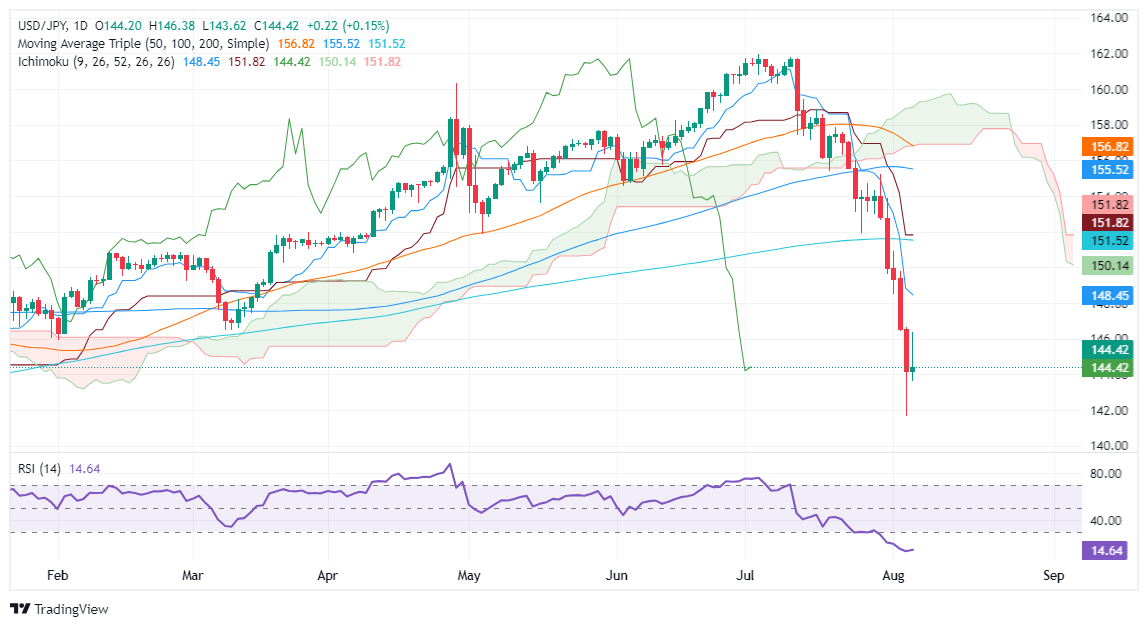- USD/JPY registers minimal gains, after briefly hitting 146.37.
- Sellers push the pair below 145.00, suggesting potential consolidation between 144.00-146.00.
- Key support levels: 144.00, August 6 low at 143.61, and August 2 bottom at 141.70.
- Resistance levels to watch: 145.00, August 5 peak at 146.37, and August 2 high at 149.77.
The USD/JPY registered minimal gains on Tuesday after hitting a daily high of 146.37. Yet buyers' failure to keep prices above the 146.00 figure sponsored a retracement toward the 144.00 region. The pair trades at 144.61, gaining 0.17% as Wednesday’s Asian session commences.
USD/JPY Price Forecast: Technical outlook
The USD/JPY rebound above 146.00 was short-lived. Sellers stepped in and pushed the exchange rate below 145.00, paving the way for subsequent losses. Although the Relative Strength Index (RSI) remains in oversold territory, price action suggests that the pair might consolidate at around 144.00-146.00 before printing the next leg-down.
If bears drag the exchange rate below 144.00, the next support would be the August 6 low of 143.61, followed by the August 2 bottom at 141.70.
Conversely, if USD/JPY edges above 145.00, the next resistance will be the August 5 peak at 146.37, followed by the 147.00 figure. on further strength, the next resistance is seen at August 2, high at 149.77.
USD/JPY Price Action – Daily Chart
Japanese Yen FAQs
The Japanese Yen (JPY) is one of the world’s most traded currencies. Its value is broadly determined by the performance of the Japanese economy, but more specifically by the Bank of Japan’s policy, the differential between Japanese and US bond yields, or risk sentiment among traders, among other factors.
One of the Bank of Japan’s mandates is currency control, so its moves are key for the Yen. The BoJ has directly intervened in currency markets sometimes, generally to lower the value of the Yen, although it refrains from doing it often due to political concerns of its main trading partners. The current BoJ ultra-loose monetary policy, based on massive stimulus to the economy, has caused the Yen to depreciate against its main currency peers. This process has exacerbated more recently due to an increasing policy divergence between the Bank of Japan and other main central banks, which have opted to increase interest rates sharply to fight decades-high levels of inflation.
The BoJ’s stance of sticking to ultra-loose monetary policy has led to a widening policy divergence with other central banks, particularly with the US Federal Reserve. This supports a widening of the differential between the 10-year US and Japanese bonds, which favors the US Dollar against the Japanese Yen.
The Japanese Yen is often seen as a safe-haven investment. This means that in times of market stress, investors are more likely to put their money in the Japanese currency due to its supposed reliability and stability. Turbulent times are likely to strengthen the Yen’s value against other currencies seen as more risky to invest in.
Information on these pages contains forward-looking statements that involve risks and uncertainties. Markets and instruments profiled on this page are for informational purposes only and should not in any way come across as a recommendation to buy or sell in these assets. You should do your own thorough research before making any investment decisions. FXStreet does not in any way guarantee that this information is free from mistakes, errors, or material misstatements. It also does not guarantee that this information is of a timely nature. Investing in Open Markets involves a great deal of risk, including the loss of all or a portion of your investment, as well as emotional distress. All risks, losses and costs associated with investing, including total loss of principal, are your responsibility. The views and opinions expressed in this article are those of the authors and do not necessarily reflect the official policy or position of FXStreet nor its advertisers. The author will not be held responsible for information that is found at the end of links posted on this page.
If not otherwise explicitly mentioned in the body of the article, at the time of writing, the author has no position in any stock mentioned in this article and no business relationship with any company mentioned. The author has not received compensation for writing this article, other than from FXStreet.
FXStreet and the author do not provide personalized recommendations. The author makes no representations as to the accuracy, completeness, or suitability of this information. FXStreet and the author will not be liable for any errors, omissions or any losses, injuries or damages arising from this information and its display or use. Errors and omissions excepted.
The author and FXStreet are not registered investment advisors and nothing in this article is intended to be investment advice.
Recommended content
Editors’ Picks

AUD/USD recovers above 0.6250 amid China's stimulus-led optimism
AUD/USD is recovering ground above 0.6250 early Monday, moving away from multi-month lows of 0.6199 set last week. The pair finds support from renewed optimism linked to reports surrounding more Chinese stimulus even as the US Dollar rebounds at the start of the Christmas week.

USD/JPY: Buyers stay directed toward 157.00
USD/JPY holds firm above mid-156.00s at the start of a new week on Monday. Doubts over when the BoJ could hike rates again and a positive risk tone undermine the safe-haven Japanese Yen while the US Dollar regains its footing after Friday's profit-taking slide.

Gold downside bias remains intact while below $2,645
Gold price is looking to extend its recovery from monthly lows into a third day on Monday as buyers hold their grip above the $2,600 mark. However, the further upside appears elusive amid a broad US Dollar bounce and a pause in the decline of US Treasury bond yields.

The US Dollar ends the year on a strong note
The US Dollar ends the year on a strong note, hitting two-year highs at 108.45. The Fed expects a 50-point rate cut for the full year 2025 versus 4 cuts one quarter earlier, citing higher inflation forecasts and a stubbornly strong labour market.

Bank of England stays on hold, but a dovish front is building
Bank of England rates were maintained at 4.75% today, in line with expectations. However, the 6-3 vote split sent a moderately dovish signal to markets, prompting some dovish repricing and a weaker pound. We remain more dovish than market pricing for 2025.

Best Forex Brokers with Low Spreads
VERIFIED Low spreads are crucial for reducing trading costs. Explore top Forex brokers offering competitive spreads and high leverage. Compare options for EUR/USD, GBP/USD, USD/JPY, and Gold.
